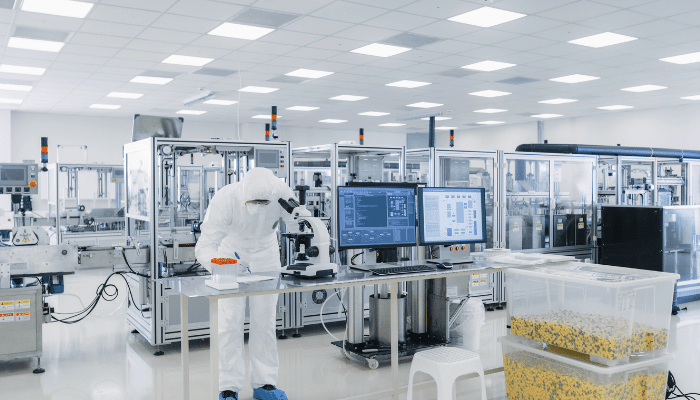IoT and Smart Manufacturing, Industry 4.0, manufacturing analytics, digital transformation. These are frequently talked about terms in the manufacturing industry. For some people, it’s just talk, some ignore it, and some are adapting and changing their current way of doing business.
You want to fall into that last group.
The industry is changing, and it has been changing for a while now. The old ways of manufacturing are behind us, and the companies staying with those old ways, are seeing the competition creep closer and surpass them.
What exactly are these old ways that I am referring to?
Industry 3.0 brought us manufacturing automation. It brought us the ability to turn on machines and let them do the work. We could produce thousands and thousands of products and materials without humans having to be directly involved in the process.
This was huge for the manufacturing industry. Manufacturing production received a massive boost, many more products were produced, much faster than before.
Where does IoT and Smart Manufacturing step in
The machines that came of out industry 3.0 are still just as valuable today. IoT and smart manufacturing, as well as Industry 4.0 principles, are not all about creating an entirely new factory and changing every piece of equipment on your plant floor.
The machines from industry 3.0 are great, but they could be even better. Whether you have a handful or hundreds of machines on your plant floor, you want all of them to be performing optimally. Any little bit of downtime, decreased efficiency, or scrap, eats into your revenue, profits, and lead times.
These numbers add up quickly. For example, let’s just say that you run a small plant with 5 machines that are running at 70% efficiency and you “should be” producing 100 parts per hour. You run these 5 machines for 8 hours a day, and end up with 2,800 parts by the end of the day. You might say that sounds pretty good. What if those machines were running at 90% efficiency? you would have 3,600 parts.
This is just one day. You could argue that 70% machine efficiency, or OEE (Overall Equipment Efficiency) is pretty low, I would argue that it is an extremely high number for a machine that is not tracking any data.
Once you start tracking a machine, you will gain the ability to improve that machine. This is where IoT and smart manufacturing takes over.
The New Way of Manufacturing
How do IoT and Smart Manufacturing solve inefficiency problems? IoT is the infrastructure implemented into your factory so that you can pull out data that your industry 3.0 machines already have. Yes, these machines have the data you need, they just need to be unlocked, they need something to extract that data. IoT makes this possible. Smart manufacturing is using the data that you pulled with your IoT system to make educated, data-driven decisions to improve efficiency across the plant floor.
You can see how these two separate things work together for better manufacturing. IoT and smart manufacturing put together make for an efficient factory that will be productive today, and competitive for years to come.
Just having those machines from industry 3.0 was great for a long time. But today with technology constantly advancing, it is not good enough to just have the equipment. And a few years down the line, IoT and smart manufacturing will only become more of a necessity.
Why IoT and Smart manufacturing is The Answer
IoT and Smart manufacturing is the new way of manufacturing, it is the key to successful manufacturing in the future. It helps you improve efficiency across the plant floor. But how does this data really help you? Here are a few specific ways that you can benefit from the data you are pulling, and how it will put more money in your pockets at the end of the day.
I mentioned the example earlier based on the machine’s efficiency, but what are some areas that could be improved that would bring up that efficiency number?
Cut Downtime
Without a doubt, downtime is a big problem and something that all manufacturers need to improve and cut back on. IoT and Smart manufacturing can assist in this area by providing the data and information you need to make adjustments. You will gain insight into how the machine is running, machine-learning so that you can pick up on tendencies for a variety of things. One area machine learning proves to be valuable is in reducing downtime. You will start to notice machine patterns before they break and cause a stoppage. With this information, you can perform a small fix. Or, make the proper adjustment to ensure that each machine on your plant floor is healthy and running strong.
Machine Learning
I touched on this briefly, because this can go hand-in-hand with cutting downtime. At least for the point that I want to bring out today. A huge benefit of IoT and smart manufacturing is reducing downtime. Although you largely cut back on the amount of downtime, there will still be unplanned stoppages and machines going down from time to time. The difference is that with IoT you have the data to assess and determine why that machine went down. No more having everyone stand in a circle around the broken machine. Trying to determine why it went down with no data and no information to come to an accurate conclusion.
With machine learning, you will instantly see what was different. You will have a pretty good idea of what you need to do to get the machine back up and running. And you can do this as fast as possible. Not only can you be more efficient in reducing downtime, but you can be more efficient when you do encounter downtime.
Improved Lead Times
You will be gaining efficiency, reducing downtime, reducing scrap, more uptime, and benefit from predictive maintenance so that machines stay healthy but also keep you from “over maintaining.” A few of these areas I have not talked about today. But, if you want more information, we have lots of articles that touch on these topics on the Ectobox blog. When you put all of this together- you get more production in less time, which leaves you with more time to make more products for more customers. It’s as simple as that. Combine these aspects with machine learning and big data, and you will have an abundance of information to provide your customers with more efficient, accurate, data-based lead times.
IoT and Smart Manufacturing Conclusion
This is undoubtedly the future of manufacturing. Modern technology is becoming more and more available to any sized company. Manufacturers need to adapt to the change. The ones willingly choosing to ignore the change will not be the ones continuing to grow and becoming industry leaders in the near future.
The Digital transformation process does not have to begin with an insanely large investment. If you work with a good manufacturing intelligence solutions integrator such as Ectobox, we can help you find the right solution for your business goal and budget.
Adapt and become an industry leader, don’t ignore the future, and get left behind.






